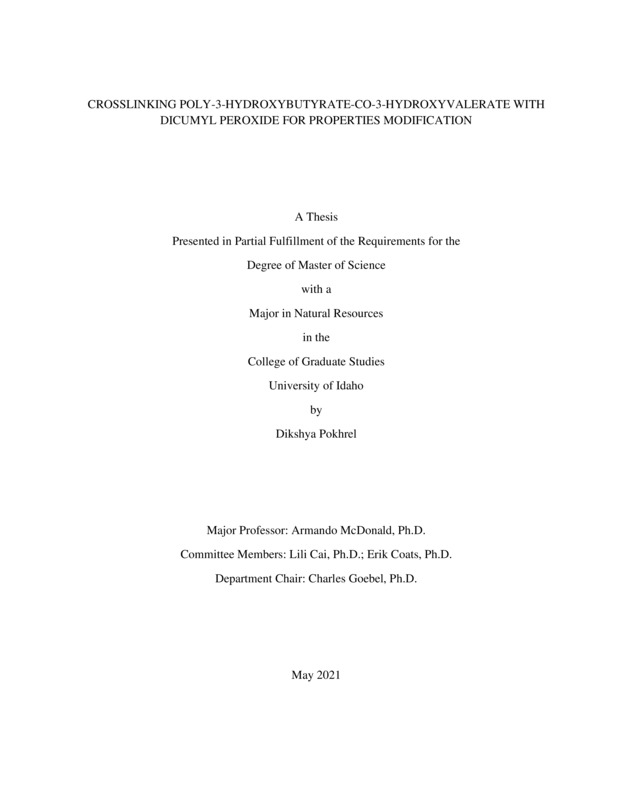Crosslinking poly-3-hydroxybutyrate-co-3-hydroxyvalerate with dicumyl peroxide for properties modification
Pokhrel, Dikshya. (2021-05). Crosslinking poly-3-hydroxybutyrate-co-3-hydroxyvalerate with dicumyl peroxide for properties modification. Theses and Dissertations Collection, University of Idaho Library Digital Collections. https://www.lib.uidaho.edu/digital/etd/items/pokhrel_idaho_0089n_12029.html
- Title:
- Crosslinking poly-3-hydroxybutyrate-co-3-hydroxyvalerate with dicumyl peroxide for properties modification
- Author:
- Pokhrel, Dikshya
- ORCID:
- https://orcid.org/0000-0002-0919-4193
- Date:
- 2021-05
- Keywords:
- Poly(3-hydroxybutyrate-co-3-hydroxyvalarate) PHBV Dicumyl peroxide Crosslinking
- Program:
- Natural Resources
- Subject Category:
- Forestry; Foreign language education
- Abstract:
-
PHAs are new generation bioplastics. Production from cheaper carbon sources by using mixed microbial cultures, accompanied with various bio-compatible characteristics has heightened research interest in PHA-based polymers. PHBV is the copolymer of PHB and PHV, tailored to overcome the drawbacks like brittleness, low melt strength of PHB homopolymer. Using DCP as a crosslinking agent was found effective in improving PHB and PHBV properties in laboratory scale experiments. Therefore, PHBV-L (laboratory), extracted from MMC fed fermented dairy manure in pilot scale production was tested to see the effect in thermal and mechanical properties due to crosslinking. The shorter reaction time of 3-min and 1% DCP improved melt strength, thermal and mechanical properties for PHBV-C (commercial). Material characterization, molecular weight calculation, rheological characterization, tensile properties, dynamic mechanical analysis, and DSC analysis were done. PHBV-L with 21% HV and Mw, 8.9 ×105 g/mol was extracted with chloroform. Double melting points (Tm1 at 126 ºC and Tm2 at 150 ºC), crystallization temperature (Tc) (85 ºC), and cold crystallization temperature (Tcc at 65 ºC) and % crystallinity (%Xc at 25%) as obtained from DSC analysis. Gel content measurement was done after Soxhlet extraction show that crosslinked gel network was not initiated by DCP addition for PHBV-L0-0.5 and negligible (<1%) gel content was obtained for PHBV-L1. Tm1 and Tm2 and %Xc, changed negligibly for PHBV-L0-1sol, whereas PHBV-L1gel show the reduction of %Xc to 9% and Tm1 and Tm2 decreased to 126.7 ºC and 144.4 ºC, respectively. 1% DCP increased tensile strength with a significant difference in modulus and increase in energy at the break. Injection molding of PHBV-L decreased its Mw by ~50% due combined effect of temperature and DCP as shown by decreased Mw and complex viscosity (η*) as % DCP increased. Processing PHBV-L at 155 ºC and 175ºC did not show a significant change in thermal properties however, a significant change in tensile property was observed for higher processing temperature. Therefore, the strength of PHBV-L did not change significantly due to crosslinking, but toughness and flexibility can be improved by 0.5-1% DCP and high processing temperature can be used for PHBV-L processing without thermal, degrading mechanical property while crosslinking effect was more favorable for 0.5-1% DCP content.
- Description:
- masters, M.S., Natural Resources -- University of Idaho - College of Graduate Studies, 2021-05
- Major Professor:
- Gabriel McDonald, Armando
- Committee:
- Coats, Erik R.; Cai, Lili
- Defense Date:
- 2021-05
- Identifier:
- Pokhrel_idaho_0089N_12029
- Type:
- Text
- Format Original:
- Format:
- application/pdf
- Rights:
- In Copyright - Educational Use Permitted. For more information, please contact University of Idaho Library Special Collections and Archives Department at libspec@uidaho.edu.
- Standardized Rights:
- http://rightsstatements.org/vocab/InC-EDU/1.0/

